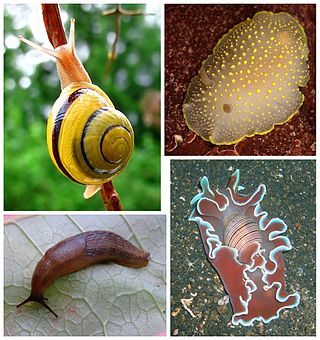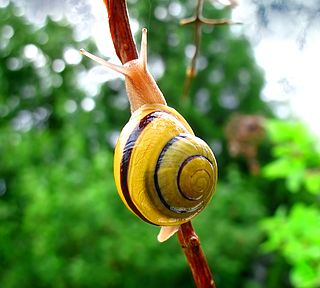
Gastropods, commonly known as slugs and snails, belong to a large taxonomic class of invertebrates within the phylum Mollusca called Gastropoda.

Opisthobranchs is a now informal name for a large and diverse group of specialized complex gastropods which used to be united in the subclass Opisthobranchia. That taxon is no longer considered to represent a monophyletic grouping.

Heterobranchia, the heterobranchs, is a taxonomic clade of snails and slugs, which includes marine, aquatic and terrestrial gastropod mollusks.

The order Cephalaspidea, also known as the headshield slugs and bubble snails, is a major taxon of sea slugs and bubble snails, marine gastropod mollusks within the larger clade Euopisthobranchia. Bubble shells is another common name for these families of marine gastropods, some of which have thin bubble-like shells. This clade contains more than 600 species.

Acteonoidea is a superfamily of sea snails, or bubble snails, marine gastropod mollusks.

Stylommatophora is an order of air-breathing land snails and slugs, terrestrial pulmonate gastropod molluscs. This taxon includes most land snails and slugs. Stylommatophorans lack an operculum, but some close their shell apertures with temporary "operculum" (epiphragm) made of calcified mucus. They have two pairs of retractile tentacles, the upper pair of which bears eyes on the tentacle tips. All stylommatophorans are hermaphrodites.

Vetigastropoda is a major taxonomic group of sea snails, marine gastropod mollusks that form a very ancient lineage. Taxonomically the Vetigastropoda are sometimes treated as an order, although they are treated as an unranked clade in Bouchet and Rocroi, 2005.

Euthyneura is a taxonomic infraclass of snails and slugs, which includes species exclusively from marine, aquatic and terrestrial gastropod mollusks in the clade Heterobranchia.

Lower Heterobranchia, also known as the Allogastropoda, is a group of rather specialized, highly evolved sea slugs and sea snails, within the subclass Heterobranchia.

Neritimorpha is a clade of gastropod molluscs that contains around 2,000 extant species of sea snails, limpets, freshwater snails, land snails and slugs. This clade used to be known as the superorder Neritopsina.

Nudipleura are a clade of sea snails and sea slugs, marine gastropod mollusks within the large clade Heterobranchia.

Siphonaria pectinata, common name the striped false limpet, is a species of air-breathing sea snail or false limpet, a marine heterobranch gastropod mollusc in the family Siphonariidae.

Acochlidiacea, common name acochlidians, are a taxonomic clade of very unusual sea snails and sea and freshwater slugs, aquatic gastropod mollusks within the large clade Heterobranchia. Acochlidia is a variant spelling.

Umbraculoidea is a superfamily of unusual false limpets with a thin soft patelliform shell, marine gastropod molluscs in the clade Umbraculida, within the clade Euopisthobranchia.

Rhodopidae is a taxonomic family of sea snails, marine opisthobranch gastropod mollusks in the superfamily Murchisonelloidea.
This overview lists proposed changes in the taxonomy of gastropods at the family level and above since 2005, when the taxonomy of the Gastropoda by Bouchet & Rocroi (2005) was published. In other words, these are recent updates in the way various groups of snails and slugs are classified.

Panpulmonata is a taxonomic clade of snails and slugs in the clade Heterobranchia within the clade Euthyneura.
Euopisthobranchia is a taxonomic clade of snails and slugs in the clade Heterobranchia within the clade Euthyneura.
Aiteng mysticus is a species of sea slug in the family Aitengidae, found around Hisamatsu, Miyako-jima, Okinawa, Japan. Morphologically it clearly belongs to the Aitengidae, but it shows differences to Aiteng ater at genus or species level. Its affinity to Aiteng ater is confirmed by comparison of the mitochondrial 16S rRNA sequences.

Pontohedyle is a genus of sea slugs, acochlidians, shell-less marine gastropod mollusks in the family Microhedylidae. Sea slugs in this genus are highly simplified and uniform.
















